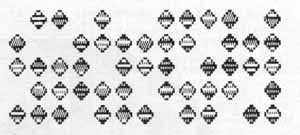
To be honest, the members of the ANALOG staff have never been very impressed with most of the software from First Star. Some of their programs, such as Bristles, had messy glitches; others just didn't cut the mustard in the fun department.
Needless to say, I was very pleasantly surprised when I saw Boulder Dash. In my opinion, this game tops all of First Star's previous efforts in terms of originality, long-lasting challenge, and just plain fun.
Original is best
In Boulder Dash, you play the part of Rockford, a small quasi-human with the power to dig through the earth. Rockford's objective is to collect as many glittering diamonds as he can.
Rockford's job isn't that easy, though. He must dodge the boulders and diamonds which fall when he digs under them. One wrong step, and Rockford is only a fond memory!
Some levels contain Fireflies, flashing objects which kill Rockford on contact. Their behavior is predictable, so Rockford can avoid them, if he keeps his eyes open. Rockford can also kill the Fireflies by dropping boulders on them.
Butterflies are another danger for Rockford to look out for. They are similar to Fireflies, but move in the opposite direction. Unlike Fireflies, Butterflies turn into diamonds when they are killed.
Other features, such as a growing green amoeba and enchanted walls (which turn boulders into diamonds and vice-versa) add to the challenge of this original game.
Long-lasting
Each level of Boulder Dash takes place in a different "cave," made up of several scrolling screens. These caves range in difficulty from "extremely easy" to "almost impossible." There are sixteen caves in Boulder Dash, each with five difficulty levels and different puzzles to solve. Rockford's time in each cave is limited, so the screens must be completed as quickly as possible.
Unlike other games, Boulder Dash doesn't simply speed up the action on each level, but rearranges the obstacles and increases Rockford's quota of diamonds.
Every four caves, you are given the chance to solve a "playable intermission" screen. If you successfully complete the screen, you are awarded a bonus Rockford. Some of these intermission screens seem more difficult than the caves (even though I've made it through all sixteen caves, there is one intermission screen I can't get through -- yet)!
![[Boulder Dash screenshot]](pictures/boulder_dash.jpg)
One nice thing about Boulder Dash is that all the caves are stored in memory while the game is being played. The computer doesn't have to access the disk each time a new level appears, so your disk is spared the extra wear.
Just plain fun
Ever since Boulder Dash arrived, publisher Lee Pappas and I have been racing to solve each level. Boulder Dash is very addictive, because each new level presents new challenges.
The level of detail in Boulder Dash is good, too. Whenever Rockford is standing still, his eyes will blink, he'll put his hands on his hips and tap his foot impatiently.
The bottom line
Being a programmer myself, I couldn't help but have a small gripe about Boulder Dash.
While the figures of Rockford, the Fireflies and Butterflies are animated smoothly, they "jump" from one position on the screen to the next. When I first saw the game, this bothered me somewhat, but after playing the game for some time I have found that it does not affect the playability at all. Boulder Dash is, quite simply, an exceptional game, and one of the best yet for the Atari computer systems.
Incidentally, as further proof of this game's appeal, Boulder Dash has recently been adapted for arcade use by Exidy!